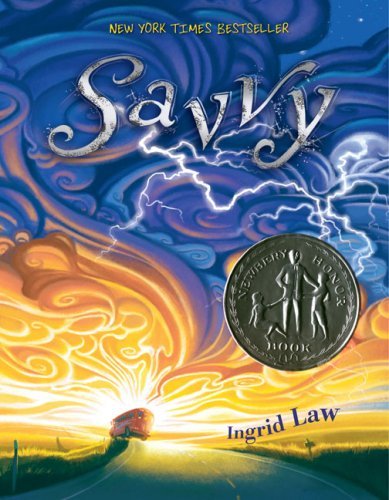 | |
| Picture from GoodReads.com |
Sammy Keyes and the Hotel Thief, byWendelin Van Draanen
Winner of the 1998 Edgar Award for Best Children's Mystery
Summary:
This book is the first in a series of books about Sammy (Samantha) Keyes, a 7th grader who lives with her Gram in a senior living apartment, as inconspicuously as she can, while her mother's abandoned her for a career in movies. Sammy is bored one day and while watching the street scenes below with her binoculars, which Gram has told her will get her into trouble one day, she witnesses a thief across the street at the Heavenly Hotel. Although she knows she shouldn't, she ends up asking questions here and there and gathering clues. Meanwhile, at school, she has to put up with a fire-headed bully, and gets suspended from school in the process, allowing her more time to investigate the thief situation. Sammy ends up figuring out the case, getting the bully back fair and square, and entertaining the readers as she goes.
Van Draanen, W. (1998). Sammy Keyes and the hotel thief. New York, NY: Knopf.
Impressions:
Sammy Keyes is a girl that everyone can love. She's flawed and she's got real issues that kids can relate to (like the sense of abandonment she feels from her mom, her encounter with the bully at school, and her inability to keep her mouth shut even if she knows better). But she isn't a complainer. She's strong and is multi-dimensional-- the kind of person that you know would have your back as your friend. She's also a good sleuth, and figures out clues mostly because she lets curiosity get the best of her and finds herself in places where she can ask questions. This is a great mystery for children and young adults alike because Sammy's voice is very realistic, it's appropriate for all age levels, and Sammy is a strong character who's fun to read about-- boys and girls alike. She's a tomboy who is street wise, and she's an observer. This book would be great for those from 4th grade on up to teens.
Professional Reviews:
"Mystery fans will welcome Samantha Keyes, a feisty 13 year old who lives with her grandmother in an apartment designated for retirees only. At home one day, Samantha trains her binoculars on the world outside. That's when she witnesses a robbery in the hotel across the street. She can't call 911 because that would give away the fact that she's spying and the authorities might discover that she is living with Gram. Instead, she waves at the thief. So begins her adventure. Later, when Sammy tries to tell police what she knows, she is hampered by their unwillingness to listen and by her need to keep her living situation a secret. Readers will love the clever way she catches the crook and they are sure to identify with this likable teenager who inadvertently gets herself into trouble. The book is full of strong characters, including Samantha's friend and fellow sleuth Marissa; Madame "Gina" Narisha, astrologist and robbery victim; Officer Borsch and Tall `n' Skinny, the investigators assigned to the crime; and Rockin' Rick, the town's favorite DJ. There are plenty of suspects and even Sammy is not immune to being accused. Pair this book with Bruce Coville's The Ghost in the Big Brass Bed (Bantam, 1991) or other titles in which the female protagonist must prove to the adults that she saw what she saw."
Plevak, L. L. (1998, July 1). [Review of the book Sammy Keyes and the hotel thief, by W. Van Draanen]. School Library Journal. Retrieved from http://www.schoollibraryjournal.com"Van Draanen (How I Survived Being a Girl, 1997) debuts a live-wire young sleuth in this nonstop whodunit. The day before starting seventh grade, Samantha peers through her grandmother's binoculars and spots the latest in a rash of burglaries. The burglar spots her right back, setting in motion a headlong chain of events that, over the next few days, takes Sammy and her rich but loyal friend Marissa from back alleys to the roof of the local mall in an effort to finger the crook while escaping his clutches. Meanwhile, Sammy also has to cope with a hostile police officer, a new school, malicious classmate Heather, andŽin the seniors-only highrise where she lives with Grams while her own mother pursues a Hollywood careerŽa suspicious neighbor. Heather's villainy and subsequent public humiliation may be overdone, but Van Draanen expertly keeps all the subplots at a rolling boil while strewing the tale with red herrings, suspects, and clever clues. Children will admire Sammy's inadvertent genius for ruffling feathers as much as they'll like her sharp powers of observation and deduction; she is a tough new gumshoe with another caper scheduled for fall. (Fiction. 10-13)"
[Review of the book Sammy Keyes and the hotel thief, by W. Van Draanen]. (1998, April 1). Kirkus' Reviews. Retrieved from http://www.kirkusreviews.comOther Uses:
For this, and mostly any other mystery, a mystery theater would be a great program for children and young adults, where you set up clues from the book, and have attendees solve them the way that Sammy does. At the end of the program, book talk these along with several other mysteries and then allow them to check them out at the end. In addition, you could give away prizes for the winner who solves the mystery first.












